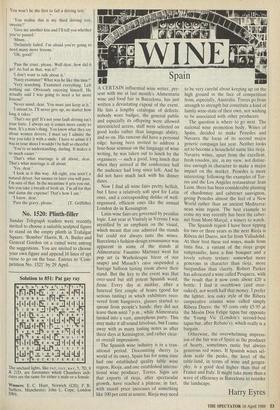111111 ego
A CERTAIN influential wine writer, pre- sent with me at last month's Alimentaria wine and food fair in Barcelona, has just written a devastating expose of the event. He lists a lengthy catalogue of defects: nobody wore badges, the general public and especially its offspring were allowed unrestricted access, staff were selected on good looks rather than language ability, and so on. His rancour did have a persOnal edge: having been invited to address a four-hour seminar on the language of wine writing, he was taken out to lunch by the organisers — such a good, long lunch that when they arrived at the conference hall the audience had long since left. And he did not have much luck with his dinner dates. . . .
Now I find all wine fairs pretty hellish, but I have a relatively soft spot for Latin ones, and a corresponding dislike of well- organised, efficient ones like the annual London do in Kensington.
Latin wine fairs are governed by peculiar logic. Last year at Vinitaly in Verona I was mystified by an emphasis on the visual, which meant that one admired the stands but could not always taste the wines. Barcelona's fashion-design renaissance was apparent in some of the stands at Alimentaria: Faustino Martinez went for pop art (a Warholesque frieze of star snaps) and Masach's cava suspended a barrage balloon tasting room above their stand. But the key to the event was that over-used but still potent Spanish word, fiesta. Every day at midday, after a funereal first couple of hours (good for serious tasting) in which exhibitors reco- vered from hangovers, glasses started to sprout from people's hands: they did not leave them until 7 p.m., while Alimentaria turned into 'a vast, amorphous party. This may make it all sound frivolous, but I came away with as many tasting notes as after three days at Kensington, and rather clear- er overall impressions.
The Spanish wine industry is in a tran- sitional period. Discounting sherry (a world of its own), Spain has for some time had one established quality table wine region, Rioja, and one established interna- tional wine producer, Torres. Signs are that exports of rioja, after spectacular growth, have reached a plateau; in fact, with recent price increases of something like 100 per cent at source, Rioja may need
to be very careful about keeping up on the high ground in the face of competition from, especially, Australia. Torres go from strength to strength but constitute a kind of family wine-state of their own, not wishing to be associated with other producers.
The question is where to go next. The national wine promotion body, Wines of Spain, decided to make Penedes and Navarra the focus of its second major generic campaign last year. Neither looks set to become a household name like rioja. Navarra wines, apart from the excellent, fresh rosados, are, in my view, not distinc- tive enough in character to make a major impact on the market. Penedes is more interesting: following the examples of Tor- res and the Los Angeles restaurateur Jean Leon, there has been considerable planting of chardonnay and cabernet sauvignon, giving Penedes almost the feel of a New World rather than an ancient Mediterra- nean wine region. The best example to come my way recently has been the caber- net from Mont-Marcal, a winery to watch.
The Spanish region I have been tipping for two or three years as the next Rioja is Ribera del Duero, not far from Valladolid. At their best these red wines, made from tinta fina, a variant of the rioja grape tempranillo, have a fine bouquet and a lovely velvety texture: somewhat more generous in character than rioja, more burgundian than clarety. Robert Parker has advocated a wine called Pesquera, with the result that it now costs about £20 a bottle: I find it overblown (and over- oaked), not worth half that money. I prefer the lighter, less oaky style of the Ribera cooperative crianza wine called simply Ribera Duero: the '85 costs only £5.95 at the Meson Don Felipe tapas bar opposite the Young Vic (London's second-best tapas bar, after Rebato's), which really is a bargain.
Otherwise, the overwhelming impress- ion of the fair was of Spain as the producer of hearty, sometimes rustic but always generous red wines. If Spanish wines sel- dom scale the peaks, the level of the table-land, in terms of wine and geogra- phy, is a good deal higher than that of France and Italy. It might take more than a wave of efficiency in Barcelona to reorder the landscape.
Harry Eyres






























































 Previous page
Previous page